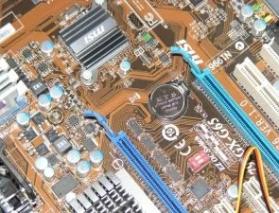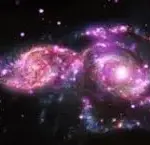 Every spiritual naturalist (and every pagan) should own a microscope. They’re relatively inexpensive: for a few hundred dollars, you can get an excellent microscope. It’s easy to learn the basic techniques for looking at tiny things, and you can progress quickly to more advanced techniques. And microscopy can teach many valuable pagan lessons.
Every spiritual naturalist (and every pagan) should own a microscope. They’re relatively inexpensive: for a few hundred dollars, you can get an excellent microscope. It’s easy to learn the basic techniques for looking at tiny things, and you can progress quickly to more advanced techniques. And microscopy can teach many valuable pagan lessons.
To use a microscope, you put things on glass slides. A favorite topic for microscopy is pond water, or some stagnant water with some algae growing in it. You take a bit of this algae-laden water and put it into a jar. This means you have to go out into the wild world, you have to use your hands to get into the environment. You bring your jar back to your microscope. You put a drop of water on a slide, cover it with a cap, and put it under your microscope lens. You then focus the microscope so you can see the tiny organisms in the water. You’ll likely see protozoans like paramecia, maybe some volvox. And the algae will look fascinating too. You’re looking at living cells.
Obviously enough, microscopes let you see things that are ordinarily too small to see. You can see things that you can’t see with your naked eyes. Say the visible world is the world as you see it with your naked eyes. The transvisible world is the world that you can see with extensions to your ordinary visual system. These include technological extensions to your eyes – ordinary glasses, binoculars, telescopes, and microscopes. And if we think of our visual system as the part of the eye-brain system engaged in normal vision, then our visual system can also be extended by other parts of your brain.
The visible and the transvisible are not opposed; they are not two distinct worlds. The visible extends into the transvisible. The transvisible world is not invisible. It is just the ordinarily unseen. It is the unseen world only if seeing is minimal. People have long used phrases like the unseen world or invisible world to refer to a world of spirits. The realm of the spirits. These spirits are disembodied intelligences, minds without bodies. But you won’t see any spirits with a microscope. The invisible world revealed by microscopes doesn’t contain any spirits. It only contains small material things.
And microscopy isn’t just passive looking. You need to operate the microscope, to change focus, changing lighting, change the position of the slide. Of course, unaided hands, like unaided eyes, are too crude to move slides in any useful way. To move slides, you’ll need a mechanical stage. A mechanical stage has little knobs for the left-right and backwards-forwards axes of motion on the stage. These knobs control tiny gears which translate your big hand movements into tiny micro-movements. If the manual is what you can do with your unaided hands, then the mechanical stage extends your dexterity from the manual to the transmanual. The transvisible and the transmanual need each other.
If you’re looking at some pond water, the organisms you’re seeing are complex physical arrangement of atoms. They are beautiful. And you’re very close to the strange liminal place where mere chemistry turns into biology, where the unliving turns into life. People often think awe involves looking at big things like the Milky Way. But looking at tiny living machines is at least as awe-inspiring.
To look at microscopic organisms is to see that atoms organized themselves in such a way that they became a living system. For the naturalist, there are no miracles here, no hands of any gods. Atoms themselves, the very physical stuff of the universe, have the potential for life. And entirely natural forces, linked with very deep principles in thermodynamics and information-theory, drove material atoms to join together to form living organisms.
Another favorite subject for microscopy is the cells of your own body. You use a toothpick to gently scrape the inside of your cheek (in your mouth). You smear a bit of it on the slide with a drop of water. You might stain it with some food coloring or iodine. You let it dry then put it under your scope. You’ll see the cells from your cheek. Your cells are the tiniest living parts of your own body. And you’ll see the nucleus in each cell. Even though you can’t see the DNA strands with an ordinary microscope, when you’re looking at the nucleus, you’re looking at the total mass of DNA. The dot in the middle of one of your cells contains the entire blueprint for your body.
When you’re looking at that DNA, you’re looking at material things that encode information. Your DNA encodes your body-plan. The information itself is not material. The information is encoded into the way the atoms are arranged. But the arrangement is neither an atom, nor a molecule, nor any material thing at all. After all, the atoms in your DNA could be re-arranged into a different sequence. The same atoms, arranged differently, would not encode your body-plan at all.
The arrangement of the atoms is not identical with the atoms. It is a form, a structure, a pattern. The information encoded in your DNA is formal. But it isn’t mental. There’s no mentality in the series of base-pairs that make up some strand of DNA. It’s just a sequence of small molecules ordered into a bigger molecule. It has no intelligence, no consciousness, no mind. Looking at your own cells through a microscope, you won’t see any tiny cellular spirits.
Yet cells do have minds. Every cell contains an intelligent control-system, which helps it do the things cells need to do to survive and reproduce. The mind in any cell is a tiny computer, a nano-brain built out of proteins, RNAs, and DNA. It is an entirely material machine that processes cellular information according to its programming. The mind of the cell is an entirely material mind. It is made up of physical switches and physical logic gates. As an intelligent control-system, the nano-mind in a cell is a little cybernetic machine. It has extremely simple beliefs about its environment and its own internal state. It has extremely simple goals and desires. The mind in the cell is pretty close to the simplicity of a self-regulating thermostat or Watts governor for a steam engine.
Multiply this cellular intelligence nearly a trillion times, and you get a human brain. One of the tricks that the human brain plays on itself, a trick that emerges from its own self-mirroring, is that the brain contains an enduring immaterial thinking substance, an ego, a self, an “I”. But this enduring immaterial ego is an illusion. As part of this illusion, the enduring ego places itself outside of the materiality of the brain. It projects itself beyond the causal order, so that it has an illusory freedom from physicality. It projects itself beyond time and space, into a false eternity.
I don’t deny the existence of eternal structures, but some of them are illusory, and the ego is one of them. So the illusory ego thinks of itself as an eternal and immaterial soul. Since the soul is free, it becomes the source of an illusory agency, the source of self-willed motion. By analogy, anything in the natural world that has any apparent agency becomes animated by a soul. The souls in the natural world, the wild world beyond the human, are often portrayed as spirits. Big spirits are gods.
Many pagans posit a world of spirits and think of gods as big spirits. They are theists. Yet these same pagans say they love nature. If you love something, you want to respect it for what it is, not treat it as an extension of your own self. To project spirits into nature is egotistical, narcissistic. If I say there are spirits in nature, then I’m projecting things like my own illusory ego into nature. I’m saying that natural things are really just like me: they somehow contain their own illusory egos. To project spirits into nature, to affirm the existence of a spirit world or realm of spirits, is to do violence to nature. It is to subjugate and dominate the wild world by turning it into something human. To be a pagan is to affirm otherness as otherness. It is to affirm a plurality of kinds of value.
There are plenty of alien, inhuman minds in the wild world, in the transvisible world. The microscopic world of cells is truly other-than-human. And it is not filled with other-than-human persons. It is filled with minds that are not persons, not personal, not mirror images of human egos.
The otherness of the microscopic is truly wild. This otherness is exactly what will kill you. Your own cells will become cancerous, or your body will be invaded by bacteria, fungi, or protozoan parasites. You will sicken and die. But the wheels in the cells will keep turning. Our corpses will be fermented by bacteria and fungi. They will be devoured and their atoms will enter the great cycles of nature. The wheels in the cells spin without regard for human greatness. They’ve been spinning for billions of years.
To look into the microscopic world is to look into the machinery that will kill you and every living thing on this earth. It is to stare straight into the abyss of nothingness. To project spirits into that abyss, into the infinitely deep wildness of nature, is a strategy the ego uses to protect itself from its fear of death. Death is pure negativity erupting into life, and destroying it. But that negativity turns back into itself, negates itself, so that new life is born. The wildness in the abyss is not a spirit, not a god, not a goddess, it is not a mind at all. It is unmind, unself, unbeing, unground. To look through a microscope, at the material wheels spinning in cells, is to see that wildness at work.
A microscope teaches you that there are many kinds of bodies, including non-human bodies. There are tiny simple bodies (that is, cells). They come together to form bigger and bigger bodies, from humans to sequoias to whales. Besides growing larger, these bodies also grow more complex, more beautiful, and more intelligent.
Beyond the bodies in our universe, there are even greater bodies, divine bodies, some of them infinite. Gods and goddesses are divine bodies. They are entirely physical things. And whatever a god or goddess may be, it is not a magnified version of an illusory human ego. Just as bacteria are transvisible, so the deities are transvisible. They are not seen by the eyes in our faces, but by the eyes in our brains. And those are entirely physical eyes.
__________
Subscribe to The Spiritual Naturalist Society
Learn about Membership in the Spiritual Naturalist Society
The Spiritual Naturalist Society works to spread awareness of spiritual naturalism as a way of life, develop its thought and practice, and help bring together like-minded practitioners in fellowship.
SNS strives to include diverse voices within the spectrum of naturalistic spirituality. Authors will vary in their opinions, terms, and outlook. The views of no single author therefore necessarily reflect those of all Spiritual Naturalists or of SNS.
__________












